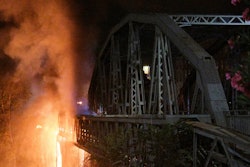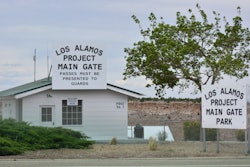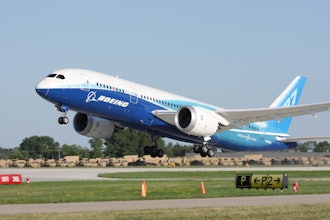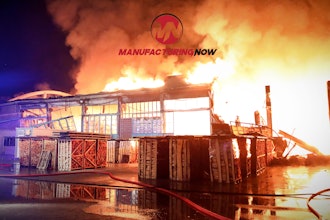
HUNTINGTON BEACH, Calif. (AP) — U.S. Coast Guard investigators have boarded a massive cargo ship as they probe what caused the rupture of an offshore oil pipeline that sent crude washing up on Southern California beaches.
The Coast Guard is investigating whether a ship anchor might have snagged and bent the pipeline owned by Amplify Energy, a Houston-based company that operates three offshore oil platforms south of Los Angeles. The Associated Press reported Wednesday that the Rotterdam Express appeared to make a series of unusual movements while anchored in the closest spot to where the break in the pipeline happened, according to data collected by a marine navigation service.
AP reviewed more than two weeks of data from MarineTraffic, a navigation service that tracks radio signals from transponders that broadcast the locations of ships and large boats every few minutes.
MarineTraffic spokesman Fotini Tseroni said in an email early Thursday that the questionable movements indicated for the Rotterdam Express on its website may have resulted from errors involving the ship’s GPS system, rather than showing the ship’s actual position. The company said it was removing the jumps in position to show that the ship stayed within its anchorage.
The Rotterdam Express, a German-flagged ship nearly 1,000 feet (305 meters) long, was assigned to anchorage SF-3, the closest to where the pipeline ruptured off Huntington Beach. Hapag-Lloyd, the shipping company that operates the Rotterdam Express, confirmed Thursday that investigators boarded the ship Wednesday while it was docked at the Port of Oakland. The company has said it played no role in the oil spill.
“We are fully cooperating with the authorities at this moment,” said Nils Haupt, a spokesman at Hapag-Lloyd's headquarters in Hamburg, Germany.
A U.S. official told the AP on Wednesday that the Rotterdam Express has become a focus of the spill investigation. The official cautioned the ship is only one lead being pursued in the investigation, which is in the early stages.
The investigators are seeking to collect tracking and navigational information from the vessel that could help them identify its exact movements, the official said. They are also seeking preliminary interviews with at least some crew members.
The official could not discuss the investigation publicly and spoke to the AP on condition of anonymity.
Petty Officer Steve Strohmaier, a Coast Guard spokesperson, declined to comment on the Rotterdam Express Wednesday but said the agency is analyzing electric charting systems from its vessel traffic service to see what ships were anchored or moving over the spill area.
The MarineTraffic data reviewed by AP showed the Rotterdam Express arrived outside the Port of Long Beach early on Sept. 22 and dropped anchor about 2,000 feet (610 meters) from the pipeline. It then showed the ship's position changing dramatically on three occasions in the following days, making it appear the ship had drifted over the pipeline. The ship's location data, which works through a global network called the Automatic Identification System, is supposed to be accurate and reliable within a few feet.
The first report of oil in the water near the pipeline were made the evening of Friday, Oct. 1. Amplify said the pipeline was shut down early Saturday morning but has not said how long it believes oil flowed from it.
Amplify’s CEO Martyn Willsher said Tuesday divers determined a 4,000-feet (1,219-meter) section of the pipeline was dislodged 105 feet (32 meters), bent back like the string on a bow. Oil escaped through a slender crack.
The amount is unclear. Amplify has said publicly that no more than 126,000 gallons (477,000 liters) leaked but told federal investigators it may be only 29,400 gallons (111,300 liters).
AP first contacted Hapag-Lloyd on Tuesday evening, seeking an explanation for the ship’s movements on Sept. 22 and 23.
On Wednesday, Nils denied that the ship ever moved off anchor from spot SF-3 during that period. He said the transponder data displayed by MarineTraffic is erroneous.
“We have proof by the logbook, which is updated hourly, that the vessel did not move,” Haupt said. “MarineTraffic in this case is wrong and the position is indeed incorrect.”
AP sent an email Wednesday morning to the Unified Command Joint Information Center for state and federal agencies responding to the oil spill, seeking comment about the movements made by the Rotterdam Express prior to the spill. Senior Chief Petty Officer Lauren Jorgensen said the command was unable to discuss matters involving an ongoing investigation.
If a ship’s anchor were to become entangled with an underwater obstacle such as a communications cable or petroleum pipeline, the operator is required by federal law to notify the Coast Guard. The locations and movements of ships are also regularly monitored by both the AIS system and radar, according to the Coast Guard.
According to MarineTraffic data, the ship left Long Beach on Monday for Oakland. It was still moored there Thursday morning, despite being scheduled to depart Wednesday night.






















